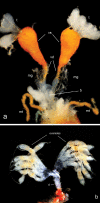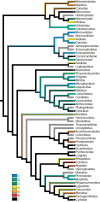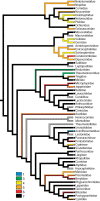A synopsis of the numbers of testicular follicles and ovarioles in true bugs (Heteroptera, Hemiptera) - sixty-five years of progress after J. Pendergrast's review
- PMID: 36762052
- PMCID: PMC9836485
- DOI: 10.3897/zookeys.1136.96431
A synopsis of the numbers of testicular follicles and ovarioles in true bugs (Heteroptera, Hemiptera) - sixty-five years of progress after J. Pendergrast's review
Abstract
The structure of testes and ovaries can be described in its simplest form by the number of follicles and ovarioles they contain. Sixty-five years after the last review of the internal reproductive systems in true bugs (Heteroptera), the data accumulated today on the number of testicular follicles and ovarioles in their gonads are summarized. In addition, data on the number and type (mesadenia/ectadenia) of accessory glands are given. The hemipteran suborder Heteroptera constitutes one of the most diverse groups of non-homometabolous ('Hemimetabola') insects, comprising more than 40,000 described species worldwide and approximately 100 families, classified into seven infraorders. Data are available for all infraorders; however, more than 90% of studied species belong to the largest and most evolutionarily derived infraorders Cimicomorpha and Pentatomomorpha. In true bugs, in general, the number of follicles varies from one to nine (in a testis), and the number of ovarioles varies from two to 24 (in an ovary). Seven follicles per testis and seven ovarioles per ovary prevail being found in approximately 43.5% (307 species) and 24.4% (367 species) of studied species, respectively. Such a structure of testes and ovaries is considered an ancestral character state in the Heteroptera. In the evolution of this group, the number of follicles and ovarioles both increased and decreased, but the trend towards a decrease clearly prevailed.
Keywords: Accessory glands; ectadenia; evolution; mesadenia; ovarioles; phylogeny; testicular follicles; true bugs.
Snejana Grozeva, Desislava Stoianova, Fedor Konstantinov, Nikolay Simov, Valentina G. Kuznetsova.
Figures



Similar articles
-
Diversity of Telomeric Sequences in True Bugs (Heteroptera): New Data on the Infraorders Pentatomomorpha and Cimicomorpha.Cytogenet Genome Res. 2025 Apr 24:1-14. doi: 10.1159/000545902. Online ahead of print. Cytogenet Genome Res. 2025. PMID: 40273892
-
Variation in the number of testicular follicles and ovarioles among 18 lacewing species of the families Myrmeleontidae, Ascalaphidae, and Nemopteridae (Insecta, Neuroptera, Myrmeleontiformia).Zookeys. 2019 Dec 3;894:33-51. doi: 10.3897/zookeys.894.47040. eCollection 2019. Zookeys. 2019. PMID: 31844408 Free PMC article.
-
Revisiting habitat and lifestyle transitions in Heteroptera (Insecta: Hemiptera): insights from a combined morphological and molecular phylogeny.Cladistics. 2019 Feb;35(1):67-105. doi: 10.1111/cla.12233. Epub 2018 Jan 29. Cladistics. 2019. PMID: 34622978
-
Systematics and evolution of Heteroptera: 25 years of progress.Annu Rev Entomol. 2011;56:487-510. doi: 10.1146/annurev-ento-120709-144833. Annu Rev Entomol. 2011. PMID: 20822450 Review.
-
The ovaries of scale insects (Hemiptera, Coccinea). Morphology and phylogenetic conclusions.Folia Histochem Cytobiol. 1998;36(4):157-65. Folia Histochem Cytobiol. 1998. PMID: 10051970 Review.
Cited by
-
First report of aberrant sperm in Edessinae and analysis of the male reproductive system of Edessa rufomarginata (De Geer, 1773) (Hemiptera: Pentatomidae).PLoS One. 2024 Dec 12;19(12):e0311254. doi: 10.1371/journal.pone.0311254. eCollection 2024. PLoS One. 2024. PMID: 39666733 Free PMC article.
References
-
- Adams TS. (2001) Morphology of the internal reproductive system of the male and female two-spotted stink bug, Perillusbioculatus (F.) (Heteroptera: Pentatomidae) and the transfer of products during mating. Invertebrate Reproduction & Development 39(1): 45–53. 10.1080/07924259.2001.9652466 - DOI
-
- Akingbohungbe AE. (1983) Variation in testis follicle number in the Miridae (Hemiptera: Heteroptera) and its relationship to the higher classification of the family. Annals of the Entomological Society of America 76(1): 37–43. 10.1093/aesa/76.1.37 - DOI
-
- Andersen EA. (1982) The semiaquatic bugs (Hemiptera, Gerromorpha): phylogeny, adaptations, biogeography, and classification. Brill, Leiden, 455 pp.
-
- Araújo VA, Bacca T, Dias LG. (2020a) Anatomy of male and female reproductive organs of stink bugs pests (Pentatomidae: Heteroptera) from soybean and rice krops. Biota Neotropica 20(4): e20201045. 10.1590/1676-0611-bn-2020-1045 - DOI
-
- Araújo VA, Oliveira AS, Cortes ICH, Viteri-D J, Dias LG. (2020b) Morphology of the male reproductive tract in two species of phytophagous bugs (Pentatomidae: Heteroptera). Journal of Entomology and Zoology Studies 8: 1608–1614.
LinkOut - more resources
Full Text Sources
